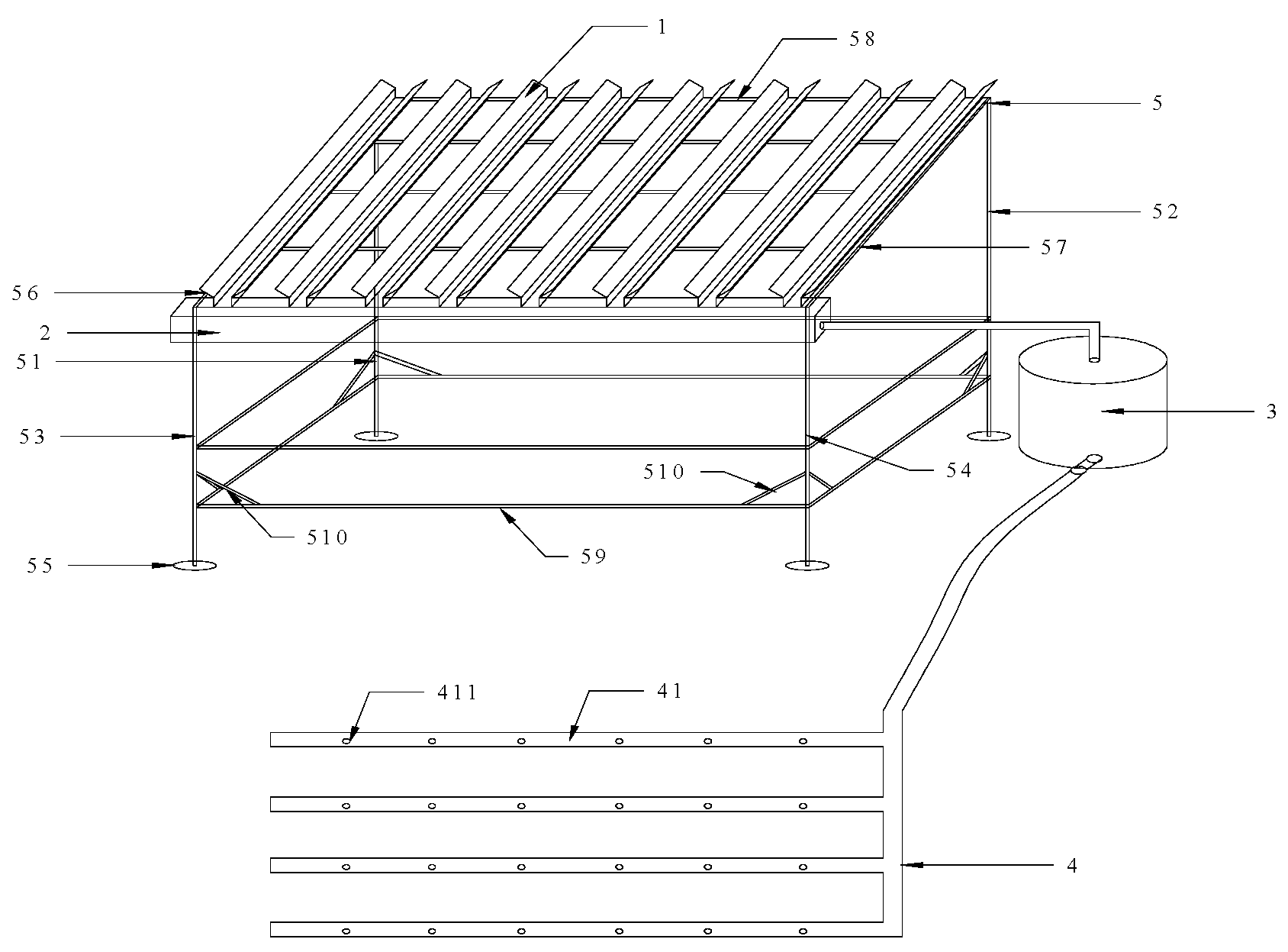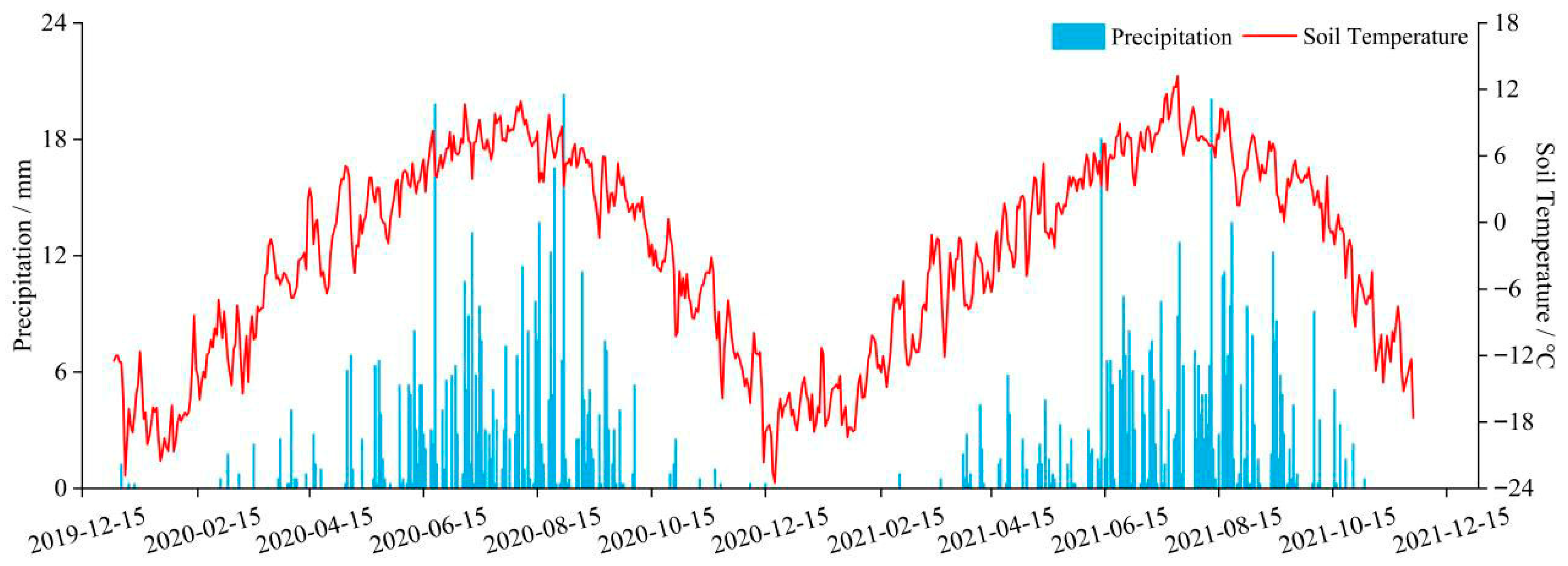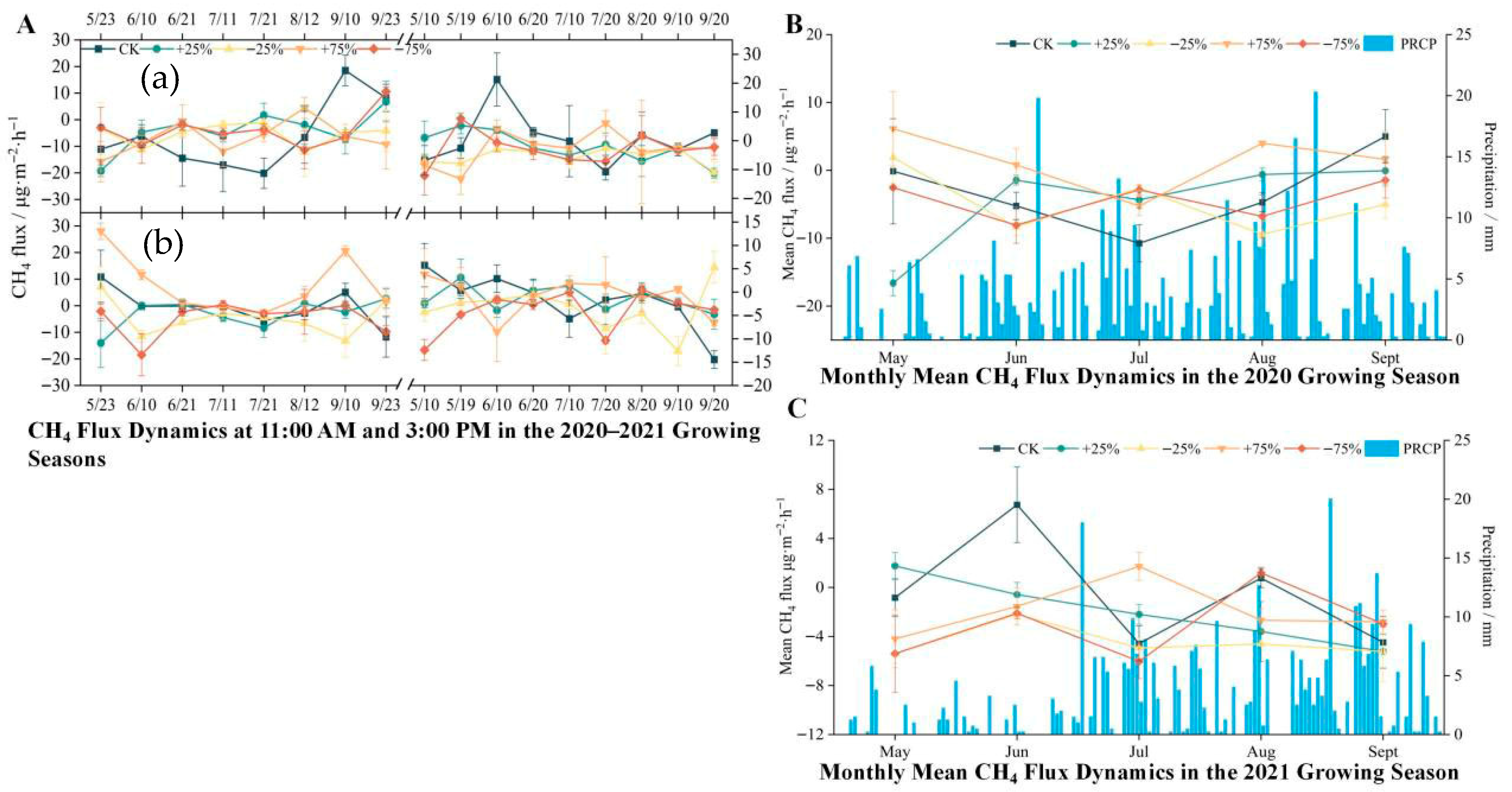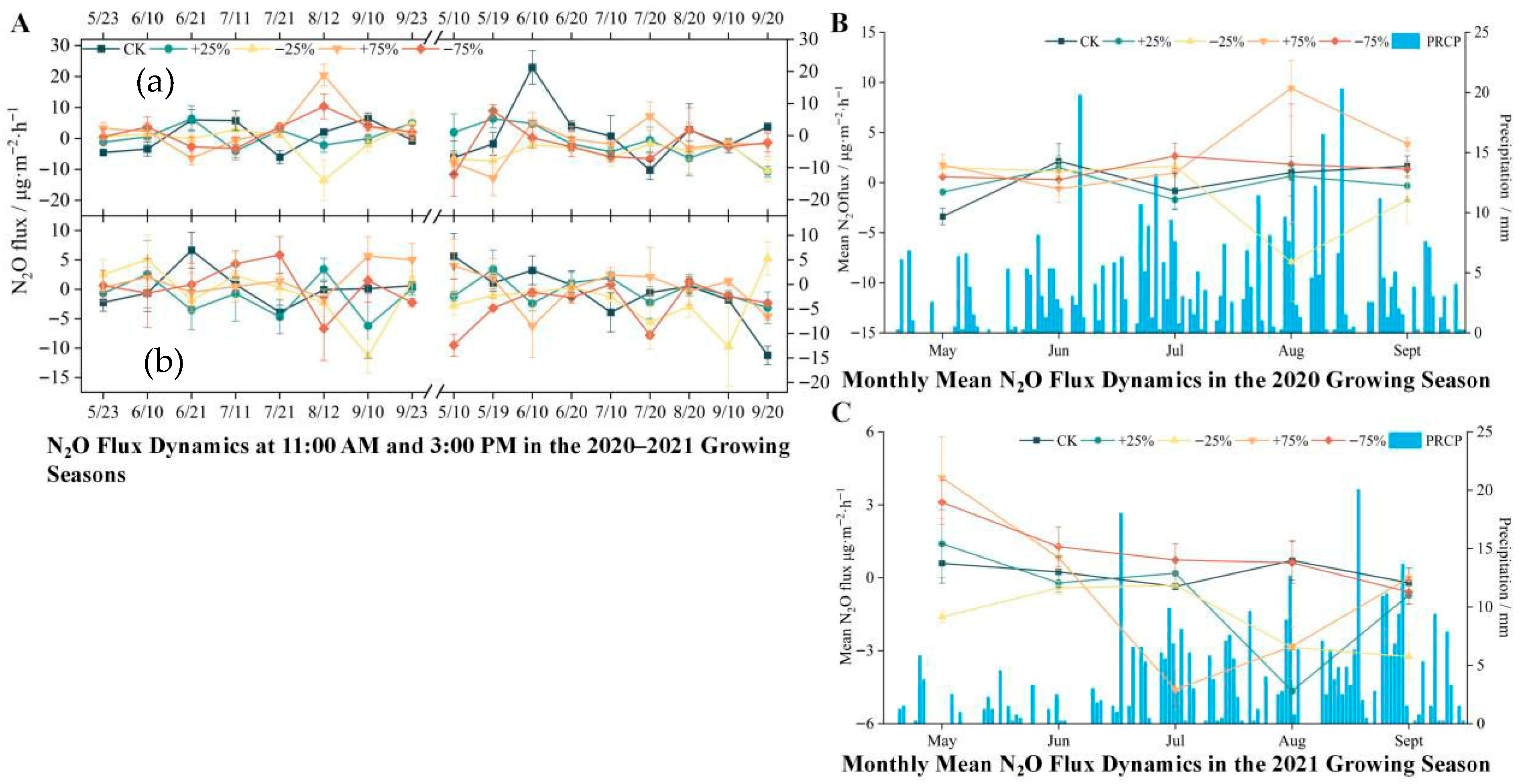Precipitation-Driven Soil and Vegetation Changes Shape Wetland Greenhouse Gas Emissions
Simple Summary
Abstract
1. Introduction
2. Materials and Methods
2.1. Study Area
2.2. Experimental Design and Sample Collection
2.2.1. Precipitation Simulation Device
2.2.2. Experimental Design
2.2.3. Gas Sampling and Analysis
2.2.4. Soil and Vegetation Sampling
2.3. Data Analysis
3. Results
3.1. Responses of Wetland Greenhouse Gases to Precipitation Manipulation
3.2. Responses of CH4 Fluxes to Precipitation Manipulation
3.3. Responses of N2O Fluxes to Precipitation Manipulation
3.4. Relationships Between Soil Physicochemical Properties and Greenhouse Gas Fluxes Under Precipitation Manipulation
3.5. Responses of Vegetation to Precipitation Manipulation
4. Discussion
4.1. Effects of Increased Precipitation on Wetland Greenhouse Gas Emissions
4.2. Effects of Reduced Precipitation on Wetland Greenhouse Gas Emissions
4.3. Effects of Soil Properties on Greenhouse Gas Emissions
4.4. Effects of Precipitation Changes on Wetland Vegetation
5. Conclusions
Author Contributions
Funding
Institutional Review Board Statement
Informed Consent Statement
Data Availability Statement
Conflicts of Interest
References
- Bongaarts, J. Intergovernmental panel on climate change special report on global warming of 1.5 °C Switzerland: IPCC. Popul. Dev. Rev. 2018, 45, 251–252. [Google Scholar] [CrossRef]
- Lloyd, D. Microbial processes and the cycling of atmospheric trace gases. Trends Ecol. Evol. 1995, 10, 476–478. [Google Scholar] [CrossRef] [PubMed]
- Liu, F.; Zhang, Y.; Liang, H.; Gao, D. Long-term harvesting of reeds affects greenhouse gas emissions and microbial functional genes in alkaline wetlands. Water Res. 2019, 164, 114936. [Google Scholar] [CrossRef] [PubMed]
- Mitsch, W.J.; Bernal, B.; Nahlik, A.M.; Mander, Ü.; Zhang, L.; Anderson, C.J.; Jørgensen, S.E.; Brix, H. Wetlands, carbon, and climate change. Landsc. Ecol. 2013, 28, 583–597. [Google Scholar] [CrossRef]
- Cui, H.; Du, Z.; Wang, L.; Yan, F.; Hu, W.; Xie, S.; Xu, Q.; Han, G. Spatiotemporal variability and controls of CH4 and CO2 emissions in an alpine reservoir: Insights from the Liujiaxia system. Ecol. Indic. 2025, 179, 114134. [Google Scholar] [CrossRef]
- Knapp, A.K.; Ciais, P.; Smith, M.D. Reconciling inconsistencies in precipitation productivity relationships: Implications for climate change. New Phytol. 2017, 214, 41–47. [Google Scholar] [CrossRef]
- Li, F.; Yang, G.; Peng, Y.; Wang, G.; Qin, S.; Song, Y.; Fang, K.; Wang, J.; Yu, J.; Liu, L.; et al. Warming effects on methane fluxes differ between two alpine grasslands with contrasting soil water status. Agric. For. Meteorol. 2020, 290, 107988. [Google Scholar] [CrossRef]
- Kayranli, B.; Scholz, M.; Mustafa, A.; Hedmark, Å. Carbon Storage and Fluxes Within Freshwater Wetlands: A Critical Review. Wetlands 2010, 30, 111–124. [Google Scholar] [CrossRef]
- Jing, J.; Shi, P.; Zong, N.; Fu, G.; Shen, Z.; Zhang, X.; Song, M. Climatic patterns modulate ecosystem and soil respiration responses to fertilization in an alpine meadow on the Tibetan Plateau, China. Ecol. Res. 2015, 30, 3–13. [Google Scholar] [CrossRef]
- Qi, C.X. Lake Area Changes and Influencing Factors on the Qinghai-Tibet Plateau. Master’s Thesis, Qinghai University, Xining, China, 2023. [Google Scholar] [CrossRef]
- Zhang, L.L.; Gao, L.M.; Chen, K.L. Characteristics of radiation balance and surface albedo changes in the Wayan Mountain wetland of the Qinghai Lake Basin. J. Glaciol. Geocryol. 2018, 40, 1216–1222. [Google Scholar] [CrossRef]
- Yang, Y.F. Study on Precipitation-Runoff Processes in the Shaliu River Basin of Qinghai Lake Based on Hydrogen-Oxygen Stable ISOTOPE technology. Master’s Thesis, Qinghai Normal University, Xining, China, 2019. [Google Scholar] [CrossRef]
- Liu, Y.; Cao, S.K.; Cao, G.C.; Chen, K.L.; Lan, Y.; Han, G.Z.; Yang, Y.F.; Lei, Y.Z. Stoichiometric characteristics of soil carbon and nitrogen in two types of alpine wetlands in Qinghai Lake. J. Southwest Agric. 2019, 32, 2630–2637. [Google Scholar] [CrossRef]
- Gao, L.M.; Zhang, L.L.; Chen, K.L. Microclimatic characteristics of wetlands in the Qinghai Lake Basin. Arid Zone Res. 2019, 36, 186–192. [Google Scholar] [CrossRef]
- Yang, Z.; Chen, K.; Liu, F.; Che, Z. Effects of Rainfall on the Characteristics of Soil Greenhouse Gas Emissions in the Wetland of Qinghai Lake. Atmosphere 2022, 13, 129. [Google Scholar] [CrossRef]
- Ding, J.X.; Chen, K.L.; Cui, H.; Ba, D.Q.Y.; Zhou, G.Y.; Jin, Y.X. Disturbance of plateau pikas on soil respiration of alpine marsh meadows. Ecol. Sci. 2019, 38, 1–7. [Google Scholar] [CrossRef]
- Wu, F.T.; Cao, S.K.; Cao, G.C.; Han, G.Z.; Lin, Y.Y.; Cheng, S.Y. Comparative study of hydrothermal fluxes in two alpine Kobresia meadow wetlands of Qinghai Lake. J. Soil Water Conserv. 2017, 31, 176–182. [Google Scholar] [CrossRef]
- Yang, Z.W.; Che, Z.H.; Liu, F.M.; Chen, K.L. Effects of precipitation gradient on diurnal variation of greenhouse gas emissions in the source wetlands of Qinghai Lake. Arid Zone Res. 2022, 39, 754–766. [Google Scholar] [CrossRef]
- Yang, Z.W.; Chen, K.L.; Zhang, L.L.; Jiang, L.L.; Zuo, D.Z. Responses of CO2, CH4, and N2O fluxes to simulated precipitation in two types of alpine wetlands in the Qinghai Lake Basin. Ecol. Sci. 2022, 41, 211–219. [Google Scholar] [CrossRef]
- Chen, Z.R.; Jiang, L.L.; Yang, Z.W.; Chen, K.L.; Ma, Y.X. An Automatic Water Diversion Device for Simulated Precipitation. CN202021447963.3, 2 April 2021. [Google Scholar]
- Lu, F.L.; Yang, X.Y.; Zhao, R.; Shan, X.L.; Wang, J.J. Study on static chamber/gas chromatography method for monitoring greenhouse gas emission in field ecosystem. Exp. Technol. Manag. 2022, 39, 15–24. [Google Scholar] [CrossRef]
- Cao, G.; Xu, X.; Long, R.; Wang, Q.; Wang, C.; Du, Y.; Zhao, X. Methane emissions by alpine plant communities in the Qinghai-Tibet Plateau. Biol. Lett. 2008, 4, 681–684. [Google Scholar] [CrossRef]
- Wu, X.; Zang, S.; Ma, D.; Ren, J.; Chen, Q.; Dong, X. Emissions of CO2, CH4, and N2O Fluxes from Forest Soil in Permafrost Region of Daxing’an Mountains, Northeast China. Int. J. Environ. Res. Public Health 2019, 16, 2999. [Google Scholar] [CrossRef]
- Vieten, B.; Conen, F.; Neftel, A.; Alewell, C. Respiration of nitrous oxide in suboxic soil. Eur. J. Soil Sci. 2009, 60, 332–337. [Google Scholar] [CrossRef]
- Wang, P.X.; Yang, Y.D.; Wang, X.Q.; Zhao, J.; Peixoto, L.; Zeng, Z.H.; Zang, H.D. Manure amendment increased the abundance of methanogens and methanotrophs but suppressed the type I methanotrophs in rice paddies. Environ. Sci. Pollut. Res. Int. 2020, 27, 8016–8027. [Google Scholar] [CrossRef] [PubMed]
- Xiao, R.; Bai, J.; Gao, H.; Huang, L.; Deng, W. Spatial distribution of phosphorus in marsh soils of a typical land/inland water ecotone along a hydrological gradient. Catena 2012, 98, 96–103. [Google Scholar] [CrossRef]
- Wang, W.Q.; Zeng, C.S.; Tong, C. Review on measurement methods and major controlling factors of methane oxidation in wetlands. J. Subtrop. Resour. Environ. 2007, 3, 55–62. [Google Scholar] [CrossRef]
- Zhao, J.X.; Luo, T.X.; Li, R.C.; Wei, H.; Li, X.; Du, M.; Tang, Y. Precipitation alters temperature effects on ecosystem respiration in Tibetan alpine meadows. Agric. For. Meteorol. 2018, 252, 121–129. [Google Scholar] [CrossRef]
- Wang, D.X.; Song, C.C.; Wang, Y.Y.; Zhao, Z.C. Comparison of CO2 fluxes between marsh wetland and grassland in the Zoige Plateau. Chin. J. Appl. Ecol. 2008, 19, 285–289. [Google Scholar]
- Li, Y.N.; Xu, S.X.; Zhao, L.; Zhang, F.W.; Zhao, X.Q. Characteristics of near-surface atmospheric CO2 concentration in alpine wetlands of Haibei, Qinghai. J. Arid Land Resour. Environ. 2007, 21, 108–113. [Google Scholar] [CrossRef]
- Ganjurjav, H.; Gao, Q.; Zhang, W.; Liang, Y.; Li, Y.; Cao, X.; Wan, Y.; Li, Y. Effects of Warming on CO2 Fluxes in an Alpine Meadow Ecosystem on the Central Qinghai-Tibetan Plateau. PLoS ONE 2015, 10, e0132044. [Google Scholar] [CrossRef]
- Song, C.C.; Yang, W.Y.; Xu, X.F.; Lou, Y.J.; Zhang, J.B. Dynamics and influencing factors of soil CO2 and CH4 emissions in marsh wetland ecosystems. Environ. Sci. 2004, 25, 1–6. [Google Scholar] [CrossRef]
- Li, Q.; Li, Z.; Zhang, Y.; Wu, X.; Yang, L.; Lu, L.; Chen, Y. Sedimentation supports life-cycle CH4 production and accumulation in a river valley reservoir: A hierarchical Bayesian modeling approach. Water Res. 2022, 222, 118861. [Google Scholar] [CrossRef]
- Song, H.; Liu, X.; Yu, W.; Wang, L. Seasonal and spatial variation of nitrogen oxide fluxes from human-disturbance coastal wetland in the Yellow River Estuary. Wetlands 2018, 38, 945–955. [Google Scholar] [CrossRef]
- Day, J.W.; Rybczyk, J.M.; Mann, M.E.; Stephens, J.R. Climate Change: Effects, Causes, Consequences Physical, Hydromorphological, Ecophysiological, and Biogeographical Changes in Coastal Wetlands and Waters. In Treatise on Estuarine and Coastal Science, 2nd ed.; Elsevier: Amsterdam, The Netherlands, 2024; Volume 6, pp. 626–641. [Google Scholar] [CrossRef]
- Shi, Z.; Thomey, M.L.; Mowll, W.; Litvak, M.; Brunsell, N.A.; Collins, S.L.; Pockman, W.T.; Smith, M.D.; Knapp, A.K.; Luo, Y. Differential effects of extreme drought on production and respiration: Synthesis and modeling analysis. Biogeosciences 2014, 11, 621–633. [Google Scholar] [CrossRef]
- Li, X.G.; Han, G.X.; Zhu, L.Q.; Sun, B.Y.; Jiang, M.; Song, W.M.; Lu, F. Effects of altered precipitation on soil respiration in coastal wetlands of the Yellow River Delta. Acta Ecol. Sin. 2019, 39, 4806–4820. [Google Scholar] [CrossRef]
- Velthuis, M.; Veraart, A.J. Temperature sensitivity of freshwater denitrification and N2O emission-A meta-analysis. Glob. Biogeochem. Cycles 2022, 36, e2022GB007339. [Google Scholar] [CrossRef]
- Luo, G.J.; Brüggemann, N.; Wolf, B.; Gasche, R.; Grote, R.; Butterbach-Bahl, K. Decadal variability of soil CO2, NO, N2O, and CH4 fluxes at the Höglwald Forest, Germany. Biogeosciences 2012, 9, 1741–1763. [Google Scholar] [CrossRef]
- Yu, F.; Li, S.Y.; Qiu, Y.Y.; Zhuo, X.X.; Huang, J.; Wang, H.; Zhu, A.; Liu, K.; Liu, L.J. Microbiological mechanisms of methane emissions from paddy fields and the effects of water-saving cultivation on methane emissions. Chin. J. Rice Sci. 2022, 36, 1–12. [Google Scholar] [CrossRef]
- Cuhel, J.; Simek, M.; Laughlin, R.J.; Bru, D.; Chèneby, D.; Watson, C.J.; Philippot, L. Insights into the effect of soil pH on N2O and N2 emissions and denitrifier community size and activity. Appl. Environ. Microbiol. 2010, 76, 1870–1878. [Google Scholar] [CrossRef]





| Year | Treatment | Dominant Species | Vegetation Cover (%) | Vegetation Height (cm) | Thickness of the Surface Vegetation Litter (cm) |
|---|---|---|---|---|---|
| 2020 | CK | Kobresia tibetica, Carex spp., Saussurea pulchra | 84 | 5.4~12.6 | 0.21 |
| +25% | Kobresia tibetica, Carex spp., Potentilla anserina, Saussurea pulchra | 92 | 6.3~17.4 | 0.16 | |
| −25% | Kobresia tibetica, Carex spp., Plantago asiatica | 82 | 4.9~15.3 | 0.28 | |
| +75% | Kobresia tibetica, Carex spp., Saussurea pulchra, Artemisia lactiflora | 90 | 7.1~17.8 | 0.37 | |
| −75% | Kobresia tibetica, Carex spp., Potentilla anserina, Lithospermum erythrorhizon | 80 | 0.9~13.7 | 0.23 | |
| 2021 | CK | Kobresia tibetica, Carex spp., Saussurea pulchra | 85 | 5.6~11.8 | 0.23 |
| +25% | Kobresia tibetica, Carex spp., Potentilla anserina, Saussurea pulchra | 93 | 7.4~17.5 | 0.31 | |
| −25% | Kobresia tibetica, Carex spp., Plantago asiatica | 81 | 5.2~13.6 | 0.25 | |
| +75% | Kobresia tibetica, Carex spp., Saussurea pulchra, Artemisia lactiflora | 87 | 8.2~16.8 | 0.28 | |
| −75% | Kobresia tibetica, Carex spp., Potentilla anserina, Lithospermum erythrorhizon, Rubus pileatus | 80 | 2.6~10.6 | 0.19 |
| Treatment | CK | +25% | −25% | +75% | −75% | |||||||||||
|---|---|---|---|---|---|---|---|---|---|---|---|---|---|---|---|---|
| Gas | CO2 | CH4 | N2O | CO2 | CH4 | N2O | CO2 | CH4 | N2O | CO2 | CH4 | N2O | CO2 | CH4 | N2O | |
| 2020 | ST | 0.01 | 0.22 | −0.02 | 0.06 | 0.41 ** | −0.15 | 0.05 | −0.06 | −0.23 | 0.07 | 0.47 ** | 0.38 * | −0.22 | 0.05 | −0.10 |
| SM | 0.16 | −0.58 ** | −0.12 | 0.54 ** | −0.27 * | −0.11 | 0.52 ** | 0.25 | 0.39 * | 0.27 * | −0.35 * | −0.24 | 0.30 * | −0.11 | −0.13 | |
| 2021 | ST | 0.37 ** | −0.17 | −0.07 | 0.24 | −0.11 | −0.15 | 0.17 | −0.01 | −0.15 | 0.01 | −0.11 | −0.14 | 0.13 | −0.15 | −0.18 |
| SM | 0.44 ** | −0.21 | −0.14 | 0.19 | −0.33 * | −0.01 | 0.27 * | −0.04 | 0.38 ** | 0.26 | 0.06 | −0.02 | 0.25 | 0.24 | 0.16 | |
| Treatment | Gas | 2020 | 2021 | ||||||
|---|---|---|---|---|---|---|---|---|---|
| TN (g/kg) | TC (g/kg) | pH | EC (uS/cm) | TN (g/kg) | TC (g/kg) | pH | EC (uS/cm) | ||
| CK | CO2 | 0.125 | 0.351 * | 0.009 | 0.146 | −0.226 | 0.321 * | −0.116 | 0.252 |
| CH4 | −0.370 * | 0.371 * | −0.175 | −0.298 | −0.215 | −0.030 | 0.096 | −0.127 | |
| N2O | 0.282 | 0.094 | 0.137 | 0.302 | −0.398 * | −0.082 | −0.803 ** | −0.648 ** | |
| +25% | CO2 | 0.209 | 0.465 ** | −0.171 | 0.033 | −0.002 | −0.042 | 0.433 * | −0.011 |
| CH4 | −0.206 | 0.309 | −0.206 | 0.151 | −0.143 | −0.120 | −0.676 ** | −0.326 * | |
| N2O | 0.318 * | −0.209 | −0.012 | −0.289 | −0.126 | −0.158 | −0.328 * | −0.090 | |
| −25% | CO2 | 0.262 | 0.422 * | −0.390 * | −0.080 | 0.531 ** | 0.575 ** | 0.211 | 0.098 |
| CH4 | 0.130 | −0.003 | −0.273 | 0.240 | −0.221 | −0.171 | −0.146 | −0.209 | |
| N2O | 0.260 | −0.013 | 0.004 | 0.057 | 0.077 | 0.032 | −0.356 * | −0.161 | |
| +75% | CO2 | 0.152 | −0.213 | −0.410 * | −0.062 | 0.240 | 0.075 | 0.326 * | 0.336 * |
| CH4 | 0.129 | −0.067 | 0.030 | 0.034 | −0.094 | 0.001 | −0.002 | −0.155 | |
| N2O | −0.210 | 0.297 | −0.431 * | 0.682 ** | −0.706 ** | −0.509 ** | −0.179 | −0.108 | |
| −75% | CO2 | 0.059 | 0.026 | 0.051 | −0.337 * | −0.014 | 0.278 | 0.084 | −0.166 |
| CH4 | −0.105 | −0.305 | −0.062 | −0.022 | 0.062 | 0.073 | 0.398 * | 0.194 | |
| N2O | −0.119 | −0.037 | 0.039 | 0.089 | −0.209 | −0.100 | −0.165 | −0.244 | |
| Year | Treatment | Plant Height /cm | Vegetation Cover /% | Aboveground Biomass /(g·m−2) | Underground Biomass /(g·m−2) | Simpson Index | Shannon Index | Pielou Evenness Index |
|---|---|---|---|---|---|---|---|---|
| 2020 | CK | 5.4~12.6 | 84 | 80.11 | 2341.52 | 0.022 | 0.670 | 0.322 |
| +25% | 6.3~17.4 | 92 | 145.90 | 2591.75 | 0.025 | 0.931 | 0.448 | |
| −25% | 4.9~15.3 | 82 | 103.488 | 2046.81 | 0.307 | 0.839 | 0.403 | |
| +75% | 7.1~17.8 | 90 | 140.69 | 3002.22 | 0.012 | 0.766 | 0.368 | |
| −75% | 0.9~13.7 | 80 | 102.98 | 1860.27 | 0.011 | 0.731 | 0.351 | |
| 2021 | CK | 5.6~11.8 | 85 | 100.74 | 1981.09 | 0.090 | 0.809 | 0.389 |
| +25% | 7.4~17.5 | 93 | 153.19 | 2040.23 | 0.035 | 0.837 | 0.402 | |
| −25% | 5.2~13.6 | 81 | 109.14 | 1823.88 | 0.317 | 0.834 | 0.401 | |
| +75% | 8.2~16.8 | 87 | 150.63 | 2195.43 | 0.063 | 0.883 | 0.425 | |
| −75% | 2.6~10.6 | 80 | 100.96 | 1462.44 | 0.086 | 0.971 | 0.425 |
Disclaimer/Publisher’s Note: The statements, opinions and data contained in all publications are solely those of the individual author(s) and contributor(s) and not of MDPI and/or the editor(s). MDPI and/or the editor(s) disclaim responsibility for any injury to people or property resulting from any ideas, methods, instructions or products referred to in the content. |
© 2025 by the authors. Licensee MDPI, Basel, Switzerland. This article is an open access article distributed under the terms and conditions of the Creative Commons Attribution (CC BY) license (https://creativecommons.org/licenses/by/4.0/).
Share and Cite
Yang, Z.; Chen, K.; Zhao, H.; Zhang, N.; Qi, D. Precipitation-Driven Soil and Vegetation Changes Shape Wetland Greenhouse Gas Emissions. Biology 2025, 14, 1663. https://doi.org/10.3390/biology14121663
Yang Z, Chen K, Zhao H, Zhang N, Qi D. Precipitation-Driven Soil and Vegetation Changes Shape Wetland Greenhouse Gas Emissions. Biology. 2025; 14(12):1663. https://doi.org/10.3390/biology14121663
Chicago/Turabian StyleYang, Ziwei, Kelong Chen, Hairui Zhao, Ni Zhang, and Desheng Qi. 2025. "Precipitation-Driven Soil and Vegetation Changes Shape Wetland Greenhouse Gas Emissions" Biology 14, no. 12: 1663. https://doi.org/10.3390/biology14121663
APA StyleYang, Z., Chen, K., Zhao, H., Zhang, N., & Qi, D. (2025). Precipitation-Driven Soil and Vegetation Changes Shape Wetland Greenhouse Gas Emissions. Biology, 14(12), 1663. https://doi.org/10.3390/biology14121663







